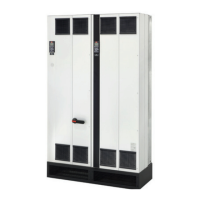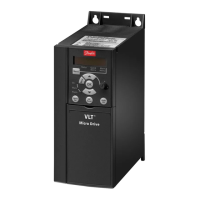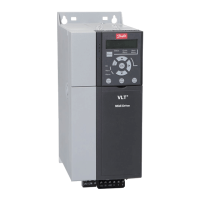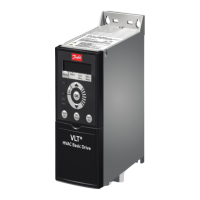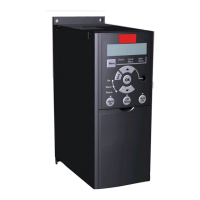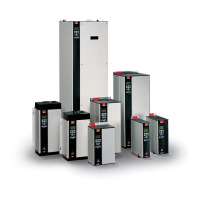Inverted input for DC braking (NC). Stops the motor by energizing it with DC current for a certain time
period, see parameter 2-01 DC Brake Current. The function is only active when the value in parameter
2-02 DC Braking Time is different from 0. This selection is not possible when parameter 1-10 Motor Con-
struction is set to [1] PM non-salient SPM.
The stop inverse function generates the stop function when the selected terminal goes from logical
level 1 to 0 (not latched). Stop is performed according to selected ramp time.
Same function as coast stop, inverse, but external interlock generates the alarm message external fault
on the display when the terminal programmed for coast inverse is logic 0. If programmed for external
interlock, the alarm message is also active via digital outputs and relay outputs. If the cause for the
external interlock is removed, the alarm can be reset using a digital input, fieldbus, or the [Reset] key.
Select start for a start/stop command. Logic 1 = start, logic 0 = stop. (Default digital input 18).
If a pulse is applied for a minimum of 2 ms, the motor starts. The motor stops when stop inverse is
activated.
Change direction of motor shaft rotation. The reversing signal only changes the direction of rotation, it
does not activate the start function. Select [2] Both directions in parameter 4-10 Motor Speed Direction. 0
= normal, 1 = reversing.
Use for start/stop and for reversing at the same time. Signals on [8] Start are not allowed at the same
time. 0 = stop, 1 = start reversing.
Used for activating jog speed. See parameter 3-11 Jog Speed [Hz]. (Default digital input 29).
Enable a selection of 1 of the 8 preset references according to Table 132.
Enable a selection of 1 of the 8 preset references according to Table 132.
Enable a selection of 1 of the 8 preset references according to Table 132.
Freeze actual reference. The frozen reference is now the point of enable/condition for speed up and
speed down to be used. If speed up/speed down is used, a speed change always follows ramp 2 (pa-
rameter 3-51 Ramp 2 Ramp Up Time and parameter 3-52 Ramp 2 Ramp Down Time) in the range parame-
ter 3-02 Minimum Reference - parameter 3-03 Maximum Reference.
Freezes actual reference. The frozen reference is now the point of enable/condition for speed up and
speed down to be used. If speed up/speed down is used, the speed change always follows ramp 2.
For digital control of the up/down speed (motor potentiometer). Activate this function by selecting
either freeze reference or freeze output. When speed up is activated for less than 400 ms, the resulting
reference is increased by 0.1%. If speed up is activated for more than 400 ms, the resulting reference
ramps according to ramp 1 in parameter 3-41 Ramp 1 Ramp Up Time.
Same as [21] Speed up, but reference decreases.
Selects 1 of the 2 setups. Set parameter 0-10 Active Set-up to multi setup.
Select which ramp to use. Logic 0 selects ramp 1, while logic 1 selects ramp 2.
A signal applied puts the into fire mode and disregards all other commands. See parameter group 24-0*
Fire Mode.
The input terminal, for which the run permissive is programmed, must be logic 1 before a start com-
mand can be accepted. Run permissive has a logic AND function related to the terminal, which is pro-
grammed for [8] Start, [14] Jog, or [20] Freeze Output. To start running the motor, both conditions must
be fulfilled. If run permissive is programmed on multiple terminals, run permissive only has to be logic
1 on 1 of the terminals for the function to be carried out. Run permissive does not affect the digital
output signal for run request ([8] Start, [14] Jog, or [20] Freeze Output) programmed in parameter group
5-3* Digital Outputs, or parameter group 5-4* Relays.
AU363928304090en-000101 / 130R0982 | 73Danfoss A/S © 2021.07
Parameters
VLT® Flow Drive FC 111
Programming Guide
